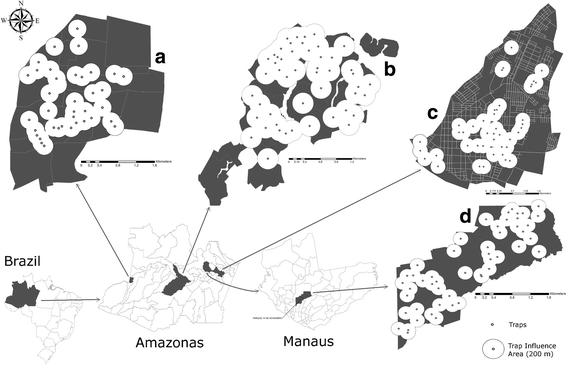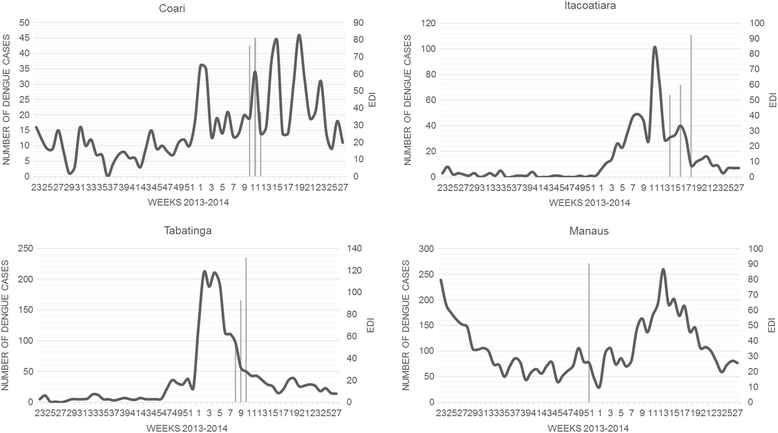Transovarial transmission of DENV in Aedes aegypti in the Amazon basin: a local model of xenomonitoring
- PMID: 28526066
- PMCID: PMC5437422
- DOI: 10.1186/s13071-017-2194-5
Transovarial transmission of DENV in Aedes aegypti in the Amazon basin: a local model of xenomonitoring
Abstract
Background: Transovarial transmission of dengue virus in Aedes spp. mosquitoes is considered an important mechanism for the maintenance of the virus in nature and may be implicated in the occurrence of outbreaks and epidemics of the disease. However, there are few studies involving transovarial transmission and viral vector monitoring as a surveillance tool and control strategy. The present study evaluated transovarial transmission of dengue virus in Aedes aegypti populations as a xenomonitoring strategy in municipalities of the Amazonas state.
Results: Aedes sp. eggs (13.164) were collected, with 30% viability of third- and fourth-instar larvae. Transovarial transmission of DENV was detected in all municipalities. The transovarial infection rate (TOR) in the municipalities was 46% of the DENV positive samples. The minimum infection rate (MIR) was 17.7 in the state, varying from 11.4 to 24.1 per 1,000 larvae tested in the respective municipalities. Four DENV serotypes were identified, with DENV I and IV being present in all municipalities investigated. The number of reported dengue fever cases varied during this period.
Conclusions: Our results suggest that transovarial transmission may be an important mechanism for the maintenance and spreading of the disease in Amazonas municipalities. Using qRT-PCR, it was possible to identify the four DENV serotypes in larval samples. The methodology used in the present study proved suitable as a DENV xenomonitoring model in immature mosquitoes, contributing to the development of systems for early detection of viral circulation and predictive models for the occurrence of outbreaks and epidemics of this disease.
Trial registration: CAAE34025414200005015 .
Keywords: Aedes aegypti; Control; Dengue; Monitoring; Ovitraps; Transovarial transmission; Xenosurveillance.
Figures


Similar articles
-
First Record of Natural Transovarial Transmission of Dengue Virus in Aedes albopictus from Cuba.Am J Trop Med Hyg. 2021 Nov 8;106(2):582-584. doi: 10.4269/ajtmh.21-0710. Am J Trop Med Hyg. 2021. PMID: 34749310 Free PMC article.
-
Transovarial transmission of dengue 1 virus in Aedes aegypti larvae: real-time PCR analysis in a Brazilian city with high mosquito population density.Can J Microbiol. 2018 Jun;64(6):393-400. doi: 10.1139/cjm-2017-0614. Epub 2018 Mar 5. Can J Microbiol. 2018. PMID: 29505732
-
Vector competence of the Aedes aegypti population from Santiago Island, Cape Verde, to different serotypes of dengue virus.Parasit Vectors. 2015 Feb 19;8:114. doi: 10.1186/s13071-015-0706-8. Parasit Vectors. 2015. PMID: 25888847 Free PMC article.
-
Dengue virus: structure, genome, evolution and challenges to control and prevent transmission.Antonie Van Leeuwenhoek. 2025 Aug 26;118(9):139. doi: 10.1007/s10482-025-02153-1. Antonie Van Leeuwenhoek. 2025. PMID: 40858865 Review.
-
The effect of temperature on dengue virus transmission by Aedes mosquitoes.Front Cell Infect Microbiol. 2023 Sep 21;13:1242173. doi: 10.3389/fcimb.2023.1242173. eCollection 2023. Front Cell Infect Microbiol. 2023. PMID: 37808907 Free PMC article. Review.
Cited by
-
Dengue, chikungunya, and Zika virus infections in Latin America and the Caribbean: a systematic review.Rev Panam Salud Publica. 2023 Feb 10;47:e34. doi: 10.26633/RPSP.2023.34. eCollection 2023. Rev Panam Salud Publica. 2023. PMID: 36788963 Free PMC article. Review.
-
Transmission competence of a new mesonivirus, Yichang virus, in mosquitoes and its interference with representative flaviviruses.PLoS Negl Trop Dis. 2020 Nov 30;14(11):e0008920. doi: 10.1371/journal.pntd.0008920. eCollection 2020 Nov. PLoS Negl Trop Dis. 2020. PMID: 33253189 Free PMC article.
-
Aquatain® causes anti-oviposition, egg retention and oocyte melanization and triggers female death in Aedes aegypti.Parasit Vectors. 2022 Mar 22;15(1):100. doi: 10.1186/s13071-022-05202-0. Parasit Vectors. 2022. PMID: 35317811 Free PMC article.
-
Study of Dengue Virus Transovarial Transmission in Aedes spp. in Ternate City Using Streptavidin-Biotin-Peroxidase Complex Immunohistochemistry.Infect Dis Rep. 2022 Sep 28;14(5):765-771. doi: 10.3390/idr14050078. Infect Dis Rep. 2022. PMID: 36286199 Free PMC article.
-
Potential Way to Develop Dengue Virus Detection in Aedes Larvae as an Alternative for Dengue Active Surveillance: A Literature Review.Trop Med Infect Dis. 2024 Mar 11;9(3):60. doi: 10.3390/tropicalmed9030060. Trop Med Infect Dis. 2024. PMID: 38535884 Free PMC article. Review.
References
-
- Vasconcelos PFC. Doença pelo vírus Zika: um novo problema emergente nas Américas? Rev. Pan-Amazônica Saúde. Instituto Evandro Chagas, Secretaria de Vigilância em Saúde, Ministério da Saúde. 2015;6:9–10.
-
- Tauil PL. Urbanização e ecologia do dengue. Cad. Saude Publica. Escola Nacional de Saúde Pública. Fundação Oswaldo Cruz. 2001;17:S99–S102. - PubMed
MeSH terms
LinkOut - more resources
Full Text Sources
Other Literature Sources
Medical
Miscellaneous

